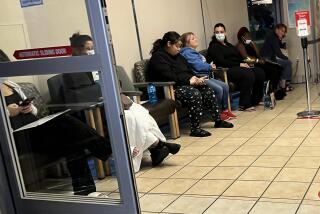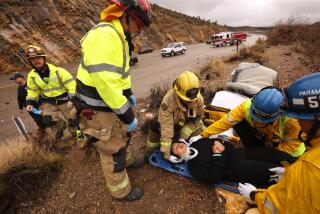A night in the ER: adrenaline, chaos and very long waits
A wall-mounted computer screen in the call center at L.A. County/USC Medical Center showed the emergency room was full. Ambulances were supposed to take patients elsewhere on this Friday night. But they kept coming — some because it was the closest ER, others because the injuries were so severe only a trauma center could handle them.
“We get them from outside hospitals, from clinics, from the field, from the jail, from police, from everywhere — everywhere,” said Alma Aviles, a nurse supervisor. “It’s like a battlefield in here.… It just doesn’t stop.”
Four patients waited on gurneys in a hallway: a homeless man with maggots in a leg wound, a jail inmate with a broken jaw, a quadriplegic with a high fever and chills, and a paralyzed homeless man with severe bedsores.
“I’m trying to get beds,” nurse Kristie Nunez told the paramedics lined up alongside the patients. “But I have none.”
This is the county’s safety net hospital, the place where the ill come for medicine, the wounded come for help, and the dying come for miracles. As many as 550 patients a day pass through its emergency room, one of the busiest in the nation. They wait an average of four hours to see a doctor — and then longer for further evaluation, treatment or an open bed.
The total wait from the time a patient arrives until he is admitted or discharged has averaged nine hours recently.
The economy has made the delays worse. More jobless and uninsured people rely on the ER for primary care and prescriptions, and by law the hospital cannot turn them away. But much of the crowding stems from the decision to replace the old County/USC, an aging, earthquake-damaged relic, with a smaller hospital.
The new hospital, which opened three years ago, has 137 emergency room beds, up from 96. But there are only 600 inpatient beds, compared with 824 before. County health officials believed that 600 would be enough because improved medical technology and case management would shorten patient stays and other hospitals would pick up the slack.
That hasn’t happened. Inpatient wards are perpetually full, so people sick enough to be admitted to the hospital often wait hours or days in the ER for a bed. While they take up space there, other patients are backed up in waiting rooms or corridors.
The crowding has become so severe that county officials acknowledge something must be done. They are discussing adding inpatient beds and transferring more patients to other hospitals, among other steps.
“A nine- or 10-hour wait is never a good thing,” said Dr. Arthur Kellermann, a Rand Corp. expert on emergency medicine. “At the least, it is demeaning, frustrating, uncomfortable, and when tempers flare, it can be dangerous.”
During a 12-hour period beginning Friday afternoon, Sept. 9, there was no letup. By 7 that evening, the big computer screen in the ER call center said “SAT,” for saturated. A nurse took a call from yet another ambulance crew.
They were bringing in a 43-year-old man who had fallen on the sidewalk after leaving a liquor store. He was confused, his head was bleeding, and his heart rate was high.
3 p.m.
The first person patients meet when they walk into the ER is nurse Joanne Rimmer. From her desk just inside the front door, she peppers them with questions. Then she decides, usually in 30 seconds or less, whether they should be fast-tracked to a physician, sent for further evaluation or parked in the waiting room.
“What’s the problem today?” she asked a man at the head of the line.
“I just want to see a doctor,” the man said, wincing and holding his stomach. “I just keeping throwing up.”
Rimmer, calm and decisive, conducted a speedy interrogation: How long have you been throwing up? Do you have a fever or chills? When was the last time you went to the doctor?
The stream of walk-in patients is nonstop — they come with chest pains, eye infections, allergic reactions, dog bites, stomachaches. Rimmer judges the severity of each one.
She sent this patient to the waiting room, where he joined dozens of others sitting in plastic chairs. An electronic sign flashed above their heads: “Patients are seen by severity of illness, not in order of arrival. Thank you for your patience.”
Jennifer Lopez, who is unemployed and lives in El Sereno, was waiting to see a doctor for a lingering kidney infection. Earlier in the week, she had borrowed $400 from her parents to pay for an appointment and antibiotics at a clinic, but the infection didn’t go away and she couldn’t afford to go back. “I came here as a last resort,” she said.
Teresita Acierto, 66, had taken two buses from Glendale to see a doctor about a swollen finger. “Even though I have Medi-Cal,” she said, “I feel more comfortable with the doctors here.”
Some afternoons, Rimmer’s line stretches out the door and she barely leaves her seat for the entire shift.
“It’s overwhelming,” she said. “I walk out and I have sensory overload.”
4:45 p.m.
In the triage area, a crowded space known as the “hot box” where patients receive a medical screening, a nurse called Jesus Iniguez’s name.
Iniguez, 70, was worried. His arm and back were hurting. He was short of breath. He was dripping with sweat. Five years ago, he’d had a heart attack. A few months ago, he had a blood clot removed.
“Do you feel like you’re having a heart attack?” nurse Lisa Baez asked him in Spanish.
“No,” he responded. “I just have this pain.”
Baez called for an EKG. The results didn’t look good.
Adrenaline pumping, Baez put Iniguez in a bed in the ER’s north wing, where he was swarmed by nurses, doctors and cardiologists. They inserted an intravenous line, gave him aspirin and oxygen, and began monitoring his heart.
About 355 doctors, residents and nurses are assigned to the ER, treating patients in a maze of color-coded rooms. A constant hum of talk, television and medical machinery fills the air, and the energy is palpable.
Like many who show up in the ER, Iniguez was having one crisis but his health problems were many and chronic: He had diabetes, high blood pressure and was overweight. Doctors repeated the heart test. He seemed to be stabilizing. They decided he should go to a critical care unit for observation. Because he was insured, Iniguez was transferred to the private USC University Hospital.
Baez headed back to her triage post.
“My line is growing,” she said.
8:15 p.m.
Irving Maldonado, who doesn’t have a job or insurance, had been in an ER bed for 34 hours. He had fallen from a ladder at his home in Watts and hit his head, fracturing his skull and causing bleeding in the brain. His sister brought him here.
“There were other people waiting, but I guess they didn’t look as severe,” said Maldonado, 29, covered in a green blanket and hooked up to an IV. “They brought me back immediately.”
Doctors determined that he should be admitted to the intensive care unit. But there were no beds available. He would have to wait in the ER. The screams, moans and constant movement made his head throb. At one point, Maldonado said, he was rolled into the hallway and left waiting there.
Doctors call this “boarding” —- when the emergency room keeps patients that should be elsewhere in the hospital. The median boarding time at County/USC in July was five hours, down from 11 in February.
When patients like Maldonado stay in the ER, “there’s somebody else in the waiting room who could be using that bed,” said ER doctor Stephen Docherty.
Boarding is linked to increased complications and a greater risk of dying because the patients aren’t getting the full range of tests and treatment in a timely manner, said John Maa, an assistant professor of surgery at UC San Francisco Medical School.
“Patients in the emergency room get lost in the cracks and sometimes they are overlooked,” he said.
8:40 p.m.
Paramedics wheeled in Gary Montero, 43, who had been knocked off his motorcycle on his way from work at the L.A. County Fair to his home in Monterey Park. The crash dislocated his shoulders, cracked a tooth, and gave him bruises and a black eye.
“Watch the arm, dude!” yelled Montero, wearing a black bandanna soaked in blood. “My shoulder’s killing me.”
A doctor brought in Montero’s motorcycle helmet, which was cracked across the front. “Did your helmet look like this before?” she asked. No, he responded. “I’m very happy you were wearing your helmet,” she said.
Doctors gave him pain medication and put his shoulders back into place. Montero, who is uninsured, told them he had been treated for high blood pressure at the county’s clinics in the past.
Nunez, the nurse supervisor, said patients don’t use the network of county-run clinics enough. “If we could get better education in the community, that would help,” she said.
But most of the clinics are open only during the day and fill up quickly. On this day, the urgent care clinic next to the ER had stopped accepting patients at 11 a.m. because of a shortage of clinicians. Everyone who arrived later would have to wait in the emergency room.
10 p.m.
The patient’s eyes darted. From his bed, he looked up at the doctors and down at the cross hanging around his neck. He moaned softly and took a deep breath. He was 25 and had been shot in the spine while standing in front of his house.
The Friday night traffic had begun. Shootings. Fights at the jail. Stabbings. Drunk-driving crashes. Drug overdoses. Psychiatric patients.
“Does your belly hurt?” a doctor asked the 25-year-old.
“Yes,” he whispered.
“Any other pain?” the doctor asked.
“My leg is a little bit numb,” he responded.
“Give yourself a little hug,” a doctor said. “We’re gonna roll you on your side.”
There it was — a red spot in the middle of his back.
A bedside ultrasound found signs of internal bleeding. He needed surgery.
To Aviles, the nurse supervisor, the man’s departure from the ER brought a sense of relief. A free bed.
“My ultimate goal is patient movement,” she said.
3 a.m.
Reginald McCray was losing his patience. He had come to the emergency room to get a refill on his epilepsy medication.
That was nine hours ago.
To get the prescription, he had to see a doctor. McCray, who was unemployed and living in transitional housing on skid row, had sat calmly for hours, periodically checking on the wait list. At about 10:30 p.m., he was one of about 85 patients waiting to be seen. At 11:15 p.m., he asked if he could come back in the morning. The nurse told him he would have to start all over again.
About 4% of patients do just that — leave without being seen.
But McCray went back to his seat. Nearby, a woman doing a crossword puzzle tapped her toes. A man covered his face with a sweat shirt and fell asleep.
By 3 a.m., McCray had finally seen a doctor and was trying to get his medicine. But he didn’t have the right identification card. His card was from the now-closed Martin Luther King Jr./Drew Medical Center. He started yelling at the person behind a glass window, prompting sheriff’s deputies to appear.
“I’m just trying to get my medication for my seizures!” McCray shouted at the officers. “I don’t know what the problem is.… This is just sick.”
More to Read
Sign up for Essential California
The most important California stories and recommendations in your inbox every morning.
You may occasionally receive promotional content from the Los Angeles Times.










